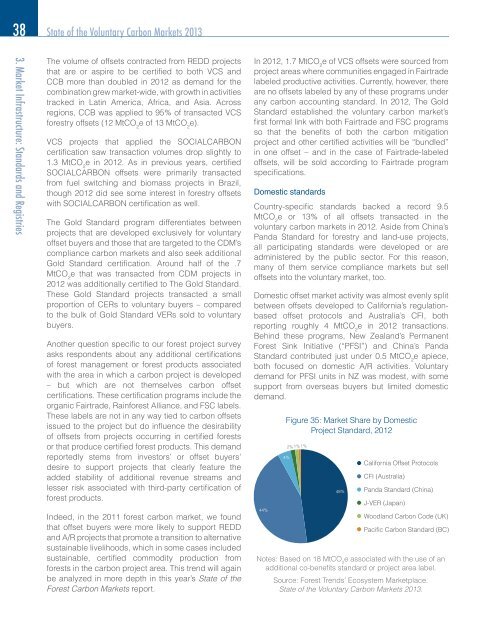Maneuvering the Mosaic: Full Report - Forest Trends
Maneuvering the Mosaic: Full Report - Forest Trends
Maneuvering the Mosaic: Full Report - Forest Trends
Create successful ePaper yourself
Turn your PDF publications into a flip-book with our unique Google optimized e-Paper software.
38 State of <strong>the</strong> Voluntary Carbon Markets 2013<br />
3. Market Infrastructure: Standards and Registries<br />
The volume of offsets contracted from REDD projects<br />
that are or aspire to be certifi ed to both VCS and<br />
CCB more than doubled in 2012 as demand for <strong>the</strong><br />
combination grew market-wide, with growth in activities<br />
tracked in Latin America, Africa, and Asia. Across<br />
regions, CCB was applied to 95% of transacted VCS<br />
forestry offsets (12 MtCO 2 e of 13 MtCO 2 e).<br />
VCS projects that applied <strong>the</strong> SOCIALCARBON<br />
certifi cation saw transaction volumes drop slightly to<br />
1.3 MtCO 2 e in 2012. As in previous years, certifi ed<br />
SOCIALCARBON offsets were primarily transacted<br />
from fuel switching and biomass projects in Brazil,<br />
though 2012 did see some interest in forestry offsets<br />
with SOCIALCARBON certifi cation as well.<br />
The Gold Standard program differentiates between<br />
projects that are developed exclusively for voluntary<br />
offset buyers and those that are targeted to <strong>the</strong> CDM’s<br />
compliance carbon markets and also seek additional<br />
Gold Standard certifi cation. Around half of <strong>the</strong> .7<br />
MtCO 2 e that was transacted from CDM projects in<br />
2012 was additionally certifi ed to The Gold Standard.<br />
These Gold Standard projects transacted a small<br />
proportion of CERs to voluntary buyers – compared<br />
to <strong>the</strong> bulk of Gold Standard VERs sold to voluntary<br />
buyers.<br />
Ano<strong>the</strong>r question specifi c to our forest project survey<br />
asks respondents about any additional certifi cations<br />
of forest management or forest products associated<br />
with <strong>the</strong> area in which a carbon project is developed<br />
– but which are not <strong>the</strong>mselves carbon offset<br />
certifi cations. These certifi cation programs include <strong>the</strong><br />
organic Fairtrade, Rainforest Alliance, and FSC labels.<br />
These labels are not in any way tied to carbon offsets<br />
issued to <strong>the</strong> project but do infl uence <strong>the</strong> desirability<br />
of offsets from projects occurring in certifi ed forests<br />
or that produce certifi ed forest products. This demand<br />
reportedly stems from investors’ or offset buyers’<br />
desire to support projects that clearly feature <strong>the</strong><br />
added stability of additional revenue streams and<br />
lesser risk associated with third-party certifi cation of<br />
forest products.<br />
Indeed, in <strong>the</strong> 2011 forest carbon market, we found<br />
that offset buyers were more likely to support REDD<br />
and A/R projects that promote a transition to alternative<br />
sustainable livelihoods, which in some cases included<br />
sustainable, certifi ed commodity production from<br />
forests in <strong>the</strong> carbon project area. This trend will again<br />
be analyzed in more depth in this year’s State of <strong>the</strong><br />
<strong>Forest</strong> Carbon Markets report.<br />
In 2012, 1.7 MtCO 2 e of VCS offsets were sourced from<br />
project areas where communities engaged in Fairtrade<br />
labeled productive activities. Currently, however, <strong>the</strong>re<br />
are no offsets labeled by any of <strong>the</strong>se programs under<br />
any carbon accounting standard. In 2012, The Gold<br />
Standard established <strong>the</strong> voluntary carbon market’s<br />
fi rst formal link with both Fairtrade and FSC programs<br />
so that <strong>the</strong> benefi ts of both <strong>the</strong> carbon mitigation<br />
project and o<strong>the</strong>r certifi ed activities will be “bundled”<br />
in one offset – and in <strong>the</strong> case of Fairtrade-labeled<br />
offsets, will be sold according to Fairtrade program<br />
specifi cations.<br />
Domestic standards<br />
Country-specifi c standards backed a record 9.5<br />
MtCO 2 e or 13% of all offsets transacted in <strong>the</strong><br />
voluntary carbon markets in 2012. Aside from China’s<br />
Panda Standard for forestry and land-use projects,<br />
all participating standards were developed or are<br />
administered by <strong>the</strong> public sector. For this reason,<br />
many of <strong>the</strong>m service compliance markets but sell<br />
offsets into <strong>the</strong> voluntary market, too.<br />
Domestic offset market activity was almost evenly split<br />
between offsets developed to California’s regulationbased<br />
offset protocols and Australia’s CFI, both<br />
reporting roughly 4 MtCO 2 e in 2012 transactions.<br />
Behind <strong>the</strong>se programs, New Zealand’s Permanent<br />
<strong>Forest</strong> Sink Initiative (“PFSI”) and China’s Panda<br />
Standard contributed just under 0.5 MtCO 2 e apiece,<br />
both focused on domestic A/R activities. Voluntary<br />
demand for PFSI units in NZ was modest, with some<br />
support from overseas buyers but limited domestic<br />
demand.<br />
44%<br />
Figure 35: Market Share by Domestic<br />
Project Standard, 2012<br />
4%<br />
2% 1% 1%<br />
48%<br />
California Offset Protocols<br />
CFI (Australia)<br />
Panda Standard (China)<br />
J-VER (Japan)<br />
Woodland Carbon Code (UK)<br />
Pacific Carbon Standard (BC)<br />
Notes: Based on 18 MtCO e associated with <strong>the</strong> use of an<br />
2<br />
additional co-benefi ts standard or project area label.<br />
Source: <strong>Forest</strong> <strong>Trends</strong>’ Ecosystem Marketplace.<br />
State of <strong>the</strong> Voluntary Carbon Markets 2013.
















